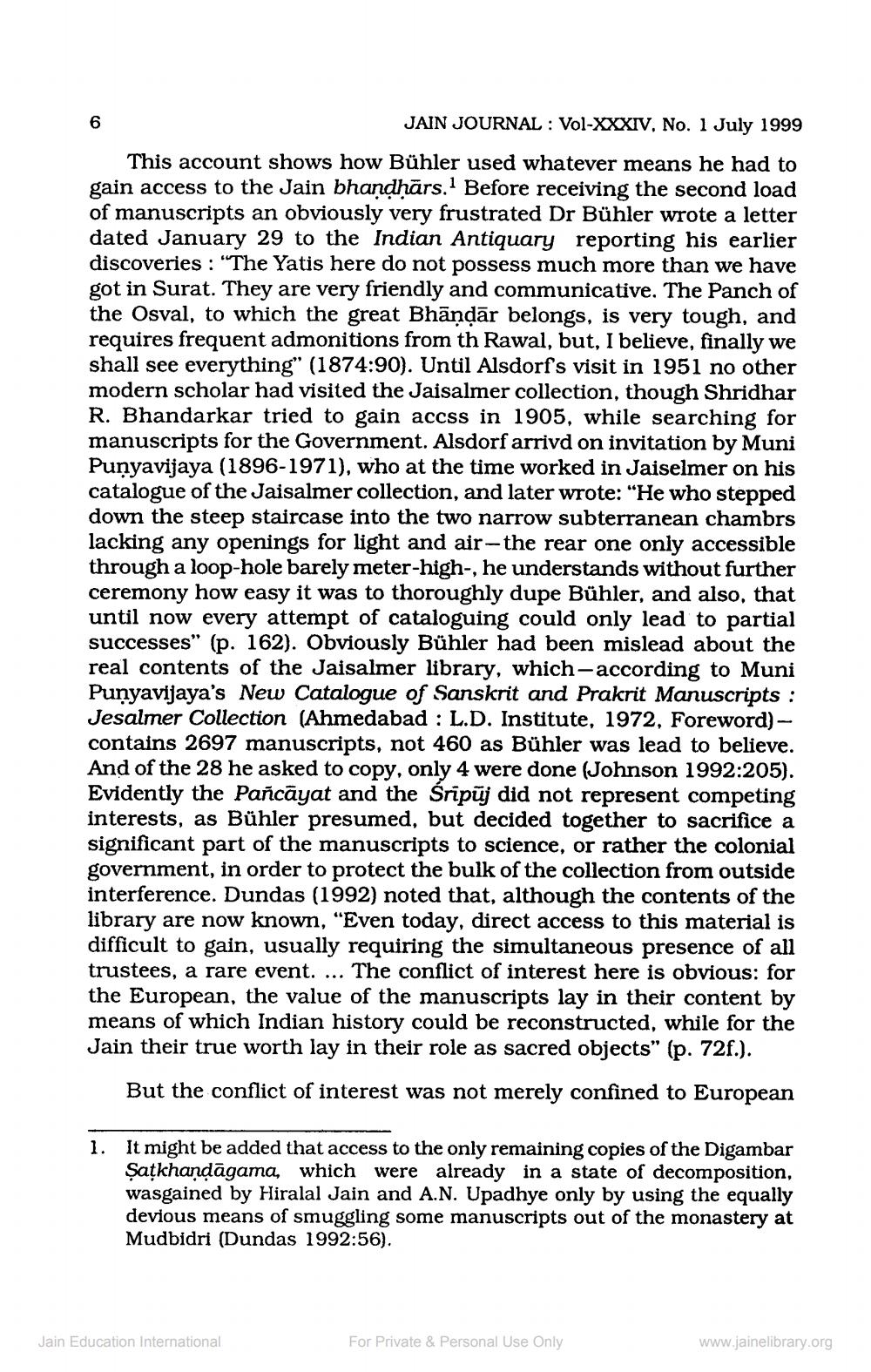Book Title: Jain Journal 1999 07 Author(s): Jain Bhawan Publication Publisher: Jain Bhawan Publication View full book textPage 8
________________ JAIN JOURNAL: Vol-XXXIV. No. 1 July 1999 This account shows how Bühler used whatever means he had to gain access to the Jain bhandḥārs.1 Before receiving the second load of manuscripts an obviously very frustrated Dr Bühler wrote a letter dated January 29 to the Indian Antiquary reporting his earlier discoveries: "The Yatis here do not possess much more than we have got in Surat. They are very friendly and communicative. The Panch of the Osval, to which the great Bhāṇḍār belongs, is very tough, and requires frequent admonitions from th Rawal, but, I believe, finally we shall see everything" (1874:90). Until Alsdorf's visit in 1951 no other modern scholar had visited the Jaisalmer collection, though Shridhar R. Bhandarkar tried to gain accss in 1905, while searching for manuscripts for the Government. Alsdorf arrivd on invitation by Muni Punyavijaya (1896-1971), who at the time worked in Jaiselmer on his catalogue of the Jaisalmer collection, and later wrote: "He who stepped down the steep staircase into the two narrow subterranean chambrs lacking any openings for light and air-the rear one only accessible through a loop-hole barely meter-high-, he understands without further ceremony how easy it was to thoroughly dupe Bühler, and also, that until now every attempt of cataloguing could only lead to partial successes" (p. 162). Obviously Bühler had been mislead about the real contents of the Jaisalmer library, which-according to Muni Punyavijaya's New Catalogue of Sanskrit and Prakrit Manuscripts : Jesalmer Collection (Ahmedabad: L.D. Institute, 1972, Foreword)contains 2697 manuscripts, not 460 as Bühler was lead to believe. And of the 28 he asked to copy, only 4 were done (Johnson 1992:205). Evidently the Pañcayat and the Śrīpuj did not represent competing interests, as Bühler presumed, but decided together to sacrifice a significant part of the manuscripts to science, or rather the colonial government, in order to protect the bulk of the collection from outside interference. Dundas (1992) noted that, although the contents of the library are now known, "Even today, direct access to this material is difficult to gain, usually requiring the simultaneous presence of all trustees, a rare event. ... The conflict of interest here is obvious: for the European, the value of the manuscripts lay in their content by means of which Indian history could be reconstructed, while for the Jain their true worth lay in their role as sacred objects" (p. 72f.). But the conflict of interest was not merely confined to European 6 1. It might be added that access to the only remaining copies of the Digambar Satkhaṇḍāgama, which were already in a state of decomposition, wasgained by Hiralal Jain and A.N. Upadhye only by using the equally devious means of smuggling some manuscripts out of the monastery at Mudbidri (Dundas 1992:56). Jain Education International For Private & Personal Use Only www.jainelibrary.orgPage Navigation
1 ... 6 7 8 9 10 11 12 13 14 15 16 17 18 19 20 21 22 23 24 25 26 27 28 29 30 31 32 33 34 35 36 37 38 39 40 41 42 43 44 45 46 47 48 49 50 51 52 53 54 55 56 57 58 59 60 61 62 63 64 65 66 67 68 69 70 71 72 73
